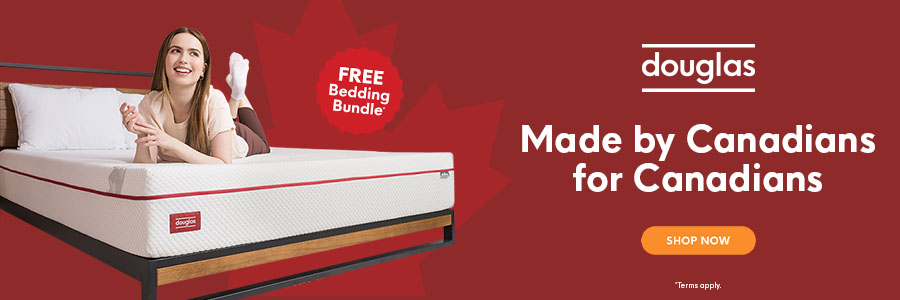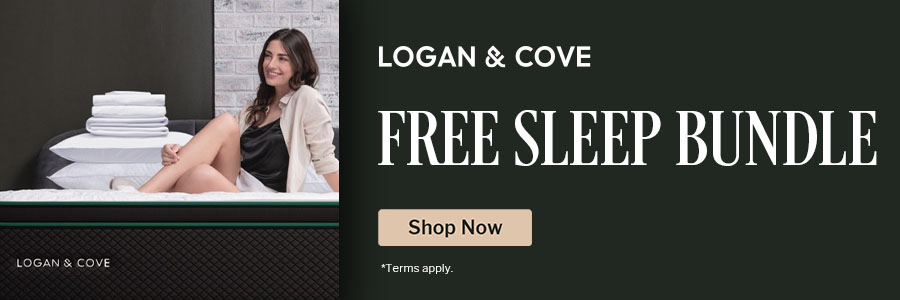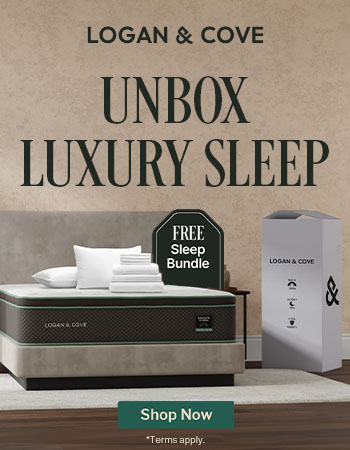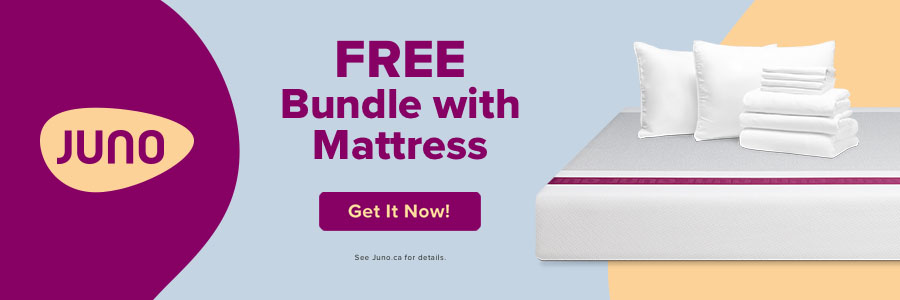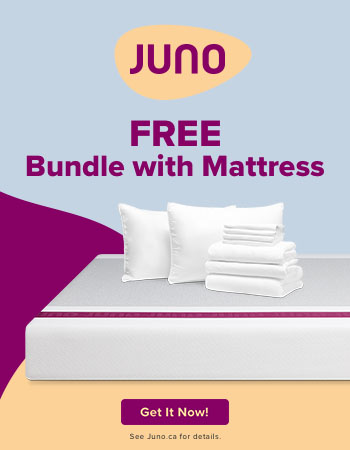Types of Mattresses: Which Mattress Type Is Right For You? (2025)
Updated: March 3, 2025 | Published: July 2, 2024The main types of mattresses are foam, innerspring, and hybrid, with some variations for each. But what makes these different types of mattresses unique? What are their pros and cons? And most importantly, which mattress type is right for you?
In this article, we’ll explore common mattress types available in Canada, as well as “other” mattress types like futons, waterbeds, and air adjustable mattresses. These are some of the most popular types of mattresses, along with the defining characteristics of each:
| Type of Mattress | Average Firmness Level | Lifespan | Average Price* |
|---|---|---|---|
Poly foam | Medium-soft to medium-firm | 7–10 years | Under $1,000 |
Memory foam | Medium-soft to medium-firm | 7–10 years | $1,000–2,000 |
Gel-infused foam | Medium-soft to medium-firm | 8–10 years | $800–2,000 |
Latex | Medium | 10–12+ years | $1,000–2,000 |
Innerspring | Medium to firm | 6–8 years | $500–1,500 |
Hybrid | Medium to medium-firm | 7–10 years | $1,000–3,000+ |
* For a queen size. Average price range reflects most common brands available in Canada. Some specialty brands will cost far more.
Foam Mattress
Foam mattresses combine foam layers of different densities to provide pressure relief, cushioning, and support. There are many different types of foam, including poly foam, memory foam, gel-infused foam, and latex.
This type of mattress is ideal for couples and restless sleepers, as well as anyone who has back pain and needs pressure-point relief.
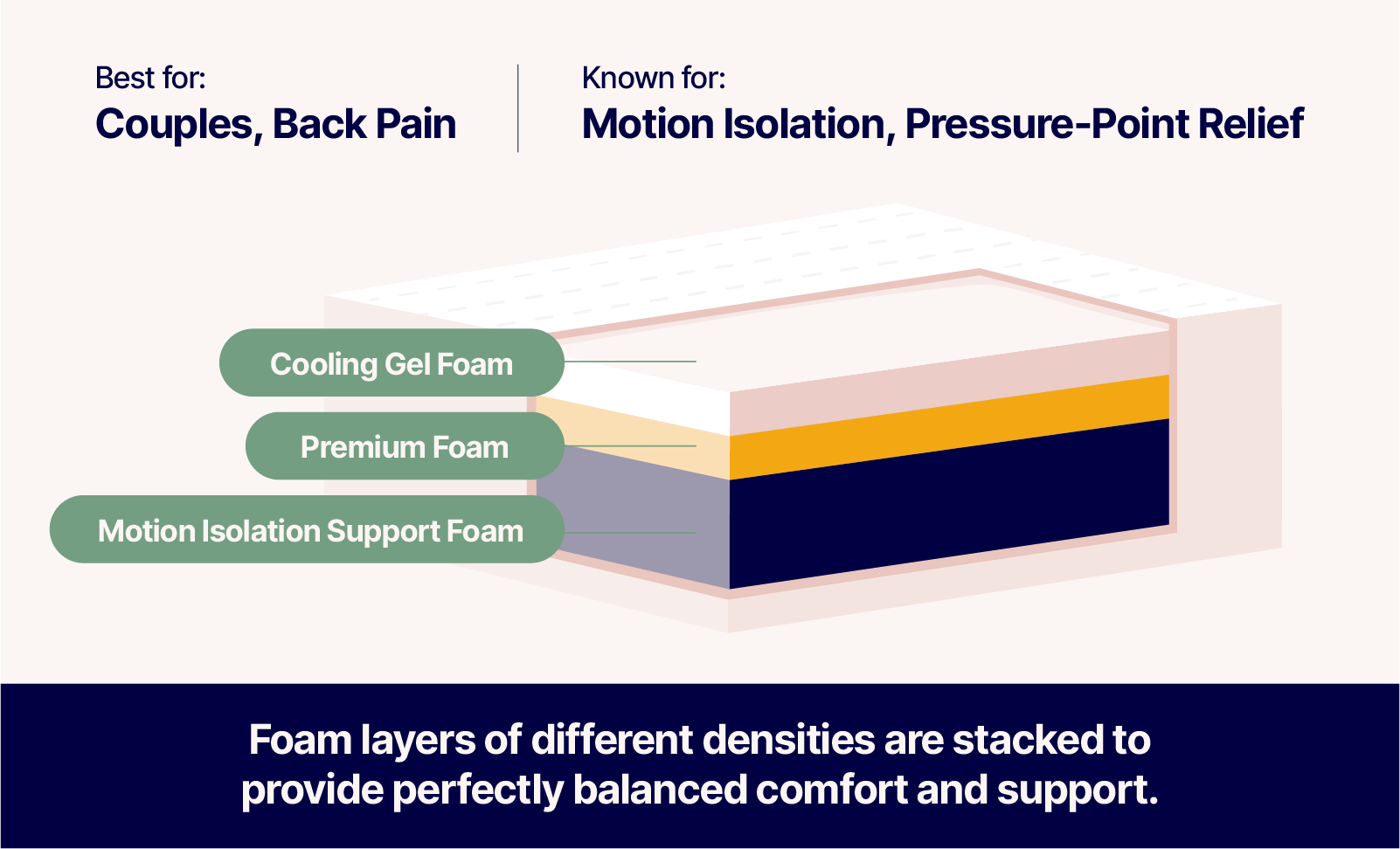
READ MORE: Get our ranking of the best foam mattresses in Canada
Poly Foam
Poly foam is a synthetic material that’s bouncier and more breathable than memory foam. A polyurethane (or “poly foam“) mattress is one of the most commonly used layers in foam mattresses. It’s often used as the upper layer in innerspring mattresses, too.
As with other types of foam, poly foam density can vary widely. Lower-density foam is cheaper to produce and will allow for a softer, less expensive mattress. High-density foam can be more expensive to manufacture, but it’s more durable, more supportive, and longer lasting.
(Looking for a value-priced foam mattress that combines poly foam and cooling foam layers? Consider Juno, one of the best affordable mattresses in Canada.)
| Pros | Cons |
|---|---|
|
|
Memory Foam
Viscoelastic (or “memory” foam) is a type of polyurethane foam containing chemicals that make the material both viscous like a fluid and elastic like a gel. This gives you a more flexible surface that gently cradles your body while you sleep.
Memory foam is the most well-known type of foam in mattresses. Its technology dates back to 1966, when it was developed to improve safety and comfort in NASA’s airplane seats. It’s now used in everything from chairs to shoes.
Memory foam adapts to different levels of pressure—like the shape of your body when you lie on it—and gradually returns to its original shape when the pressure is removed. Traditional memory foam has closed cells that trap heat, while open-cell memory foam has open cells that increase airflow throughout the mattress.
READ MORE: Get our ranked list of the best memory foam mattresses
(Enjoy the feel of memory foam and want the ultimate in cooling comfort? You’ll love Octave, our pick for Best Sleep 2025.)
| Pros | Cons |
|---|---|
|
|
Gel Foam
Gel foam is a type of memory foam that uses gel to transfer heat away from your body for a cooler sleep. Cooling is an essential feature for traditional memory foam, even if you don’t sleep hot, because you sink deeper into the mattress and the foam traps your body heat.
Some mattress manufacturers use gel-infused memory foam, which is made from a viscoelastic material similar to traditional memory foam mattresses. Liquid gel is often swirled into or layered on top of the foam, or millions of miniature thermal gel beads are infused into the foam. Other mattress manufacturers use gel “pods,” which they may claim adds extra bounce.
(Interested in a mattress with gel foam for a cool, comfortable sleep? Try Douglas, our Top Pick 2025 and #1 on our list of the best mattresses in Canada.)
| Pros | Cons |
|---|---|
|
|
Latex
Latex foam is a comfortable, responsive type of foam with an open cell structure. This provides good ventilation and airflow without trapping heat. Latex mattresses can use either natural latex alone, or a combination of natural and synthetic latex. Natural latex comes from the sap of a rubber tree and is processed into blocks of latex foam.
| Pros | Cons |
|---|---|
|
|
Innerspring Mattress
Innerspring mattresses use a thin comfort layer, usually 2″ or less, overtop a set of coils. The comfort layer can be made of materials like foam, fibre padding like cotton or wool, or upholstery materials.
An innerspring mattress tends to be cooler than an all-foam mattress. You won’t sink as far into the mattress, and you can shift positions more easily. You’ll also get better airflow, edge support, and bounce, thanks to the coil base support system.
Because of the lower price tag and reduced level of comfort, innerspring mattresses are best for budget shoppers and short-term accommodations, like guest rooms, hotels, and RVs.
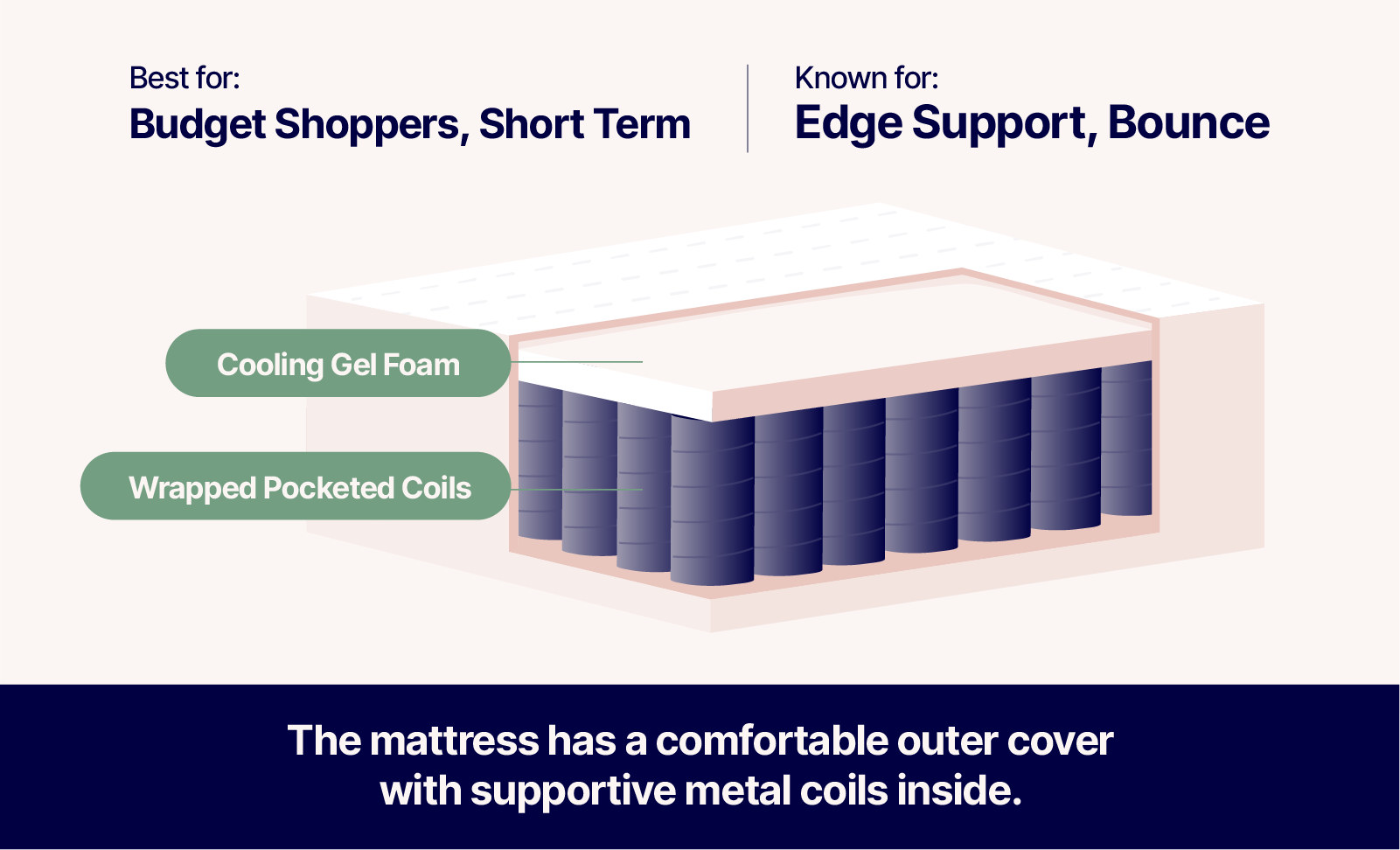
READ MORE: What is the difference between foam vs spring mattresses?
An innerspring mattress can have one of four different types of coil systems: continuous, Bonnell, offset, or pocket coils.
Continuous Coils
Continuous coil (also known as open coil) systems use rows of wires formed into a single layer of interconnected circular coils. This type of coil is shaped like an hourglass, with a thin foam layer on top.
| Pros | Cons |
|---|---|
|
|
Bonnell Coils
Bonnell coils are open and hourglass-shaped. A thinner middle point responds to minimal pressure, and thicker parts at the top and bottom are designed to respond to greater pressure.
| Pros | Cons |
|---|---|
|
|
Offset Coils
Offset coils are similar to Bonnell coils. This type of mattress coil is interconnected, but it’s not as rounded, and it flexes like a hinge when compressed.
| Pros | Cons |
|---|---|
|
|
Pocketed Coils
Pocketed coils are multiple smaller coils, individually wrapped in fabric. Each coil operates independently and only flexes when pressure is applied.
| Pros | Cons |
|---|---|
|
|
Micro Coils
Like pocket coils, the smaller micro coils are individually wrapped and work independently to provide support, pressure relief, and contouring. Micro coils are often paired with pocket coils as an additional layer.
| Pros | Cons |
|---|---|
|
|
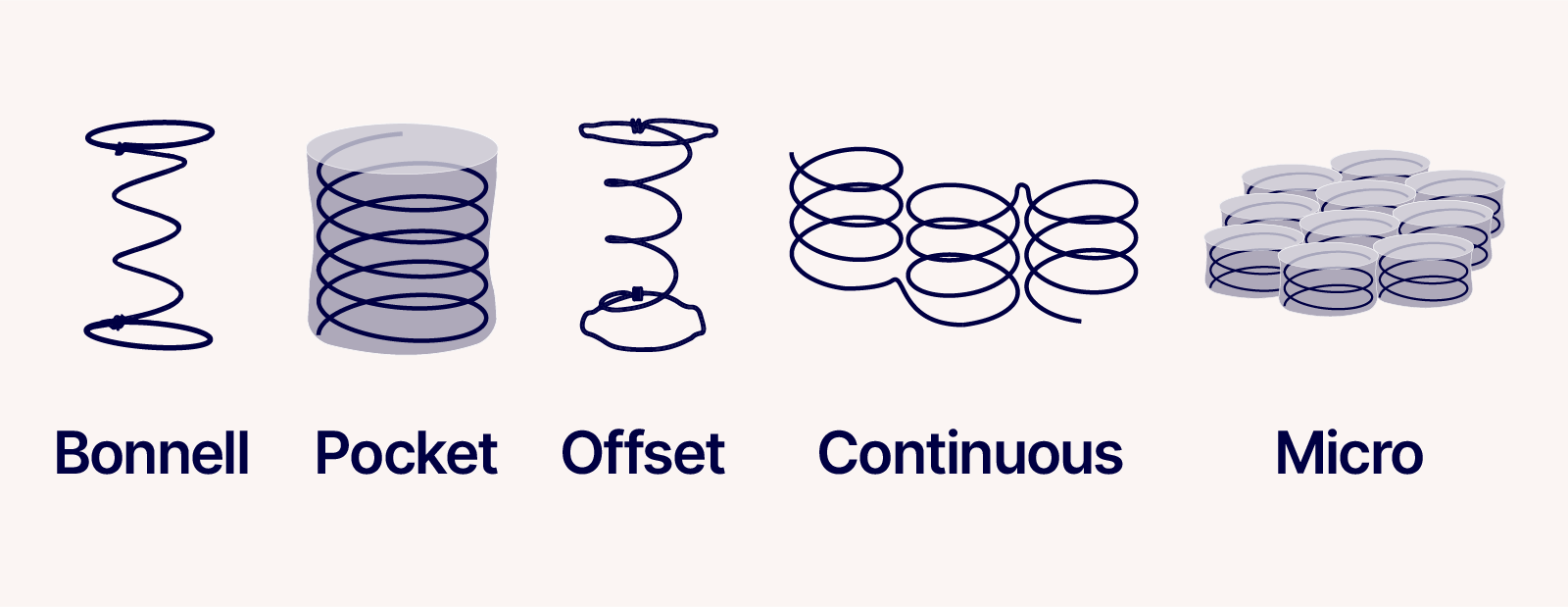
Hybrid Mattress
Where innerspring mattresses have a thin comfort layer, hybrid mattresses are a true pairing of foam and coils. Hybrids offer the best of both worlds: the pressure-relieving, contouring qualities of foam with all the bounce and responsiveness of innersprings.
This type of mattress usually has one or more comfort foam layers with at least one layer of supportive coils. Some mattresses use multiple layers of foam to create a single top comfort layer, usually at least 2″ in height. These layers can combine poly foam, gel-infused memory foam, and other materials.
READ MORE: Foam vs hybrid mattress: which mattress type should you choose?
Quality hybrid mattresses will also include a responsive transition layer between the comfort layer and support layer, giving you extra comfort and pressure relief. This layer could be more foam, or even a layer of micro-coils for extra spine alignment and pressure-point relief.
The bottom support layer uses coils of various thicknesses. Look for individually wrapped steel pocketed coils, which provide good motion isolation for a more restful sleep.
The best hybrids have coils arranged in zones, with thicker coils for hips, thinner coils for your shoulders and knees, and reinforced coils around the mattress perimeter. While this combination can cost more, it provides excellent cushioning and targeted support.
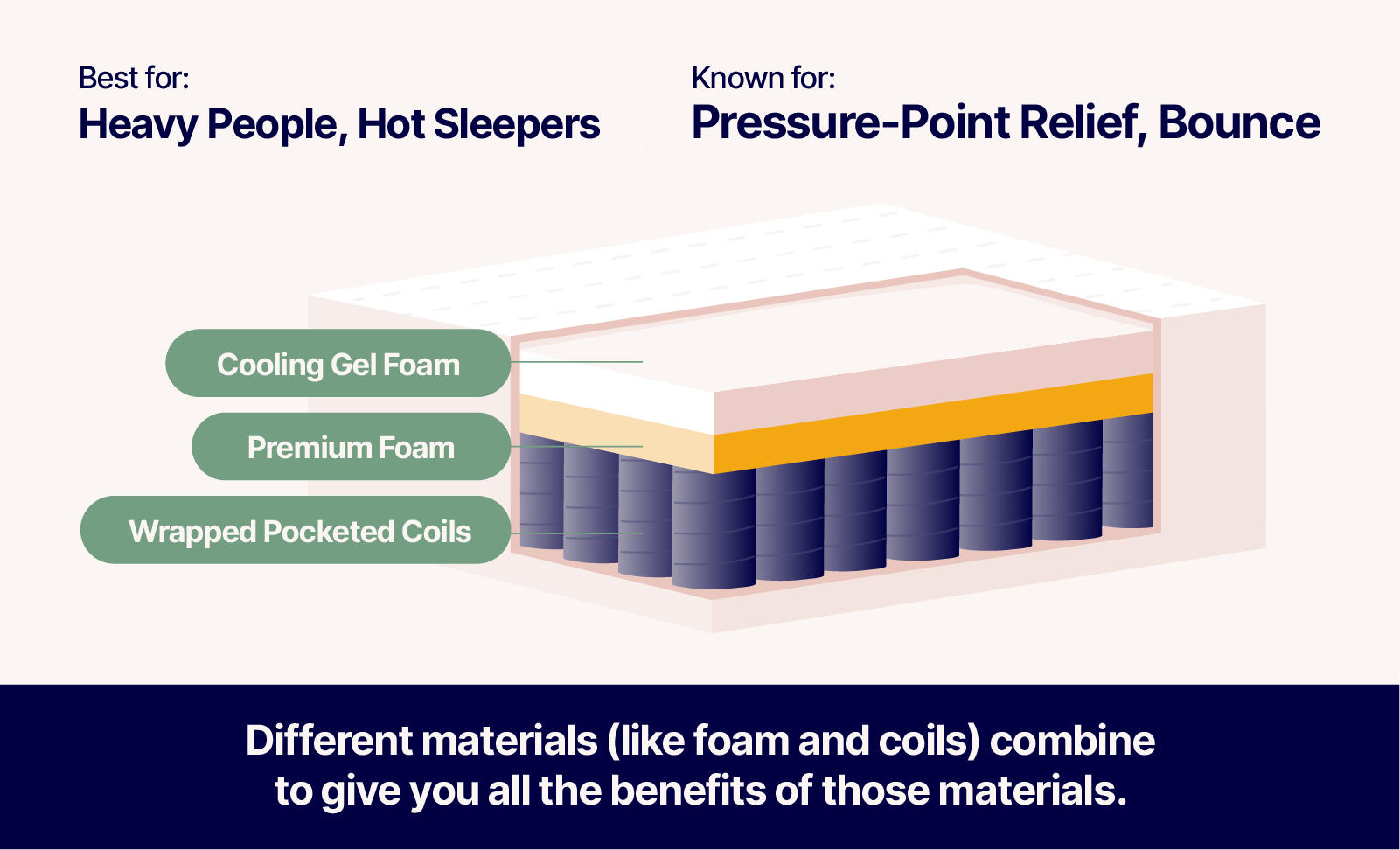
READ MORE: What is a hybrid mattress?
A hybrid mattress is best for couples with different support needs or body types, heavier sleepers, combination sleepers, and anyone who likes the support of innerspring for back and shoulder pain.
This type of mattress keeps your spine aligned in most positions and provides full-body support—without making you feel like you’re sinking into the mattress.
(In the market for a hybrid mattress? Check out Logan & Cove, our Best Hybrid 2025 and the best hybrid mattress in Canada.)
| Pros | Cons |
|---|---|
|
|
Other Mattress Types
Futon
A futon is a traditional Japanese style of bedding that became popular in North America in the 1980s. This type of mattress is filled with cotton batting and has cotton ticking held in place with hand-sewn tufting. It looks similar to a mattress topper.
Futons are still used today in Canada by some budget shoppers. Western-style futons can be folded into a low sofa bed and are often laid on slatted frame bases. They lack cushioning or contouring but can be layered to provide the right comfort level.
READ MORE: Types of bed frames: which style is right for you?
Waterbed
Waterbeds (also known as flotation beds) enjoyed a high level of popularity in the 1970s and 1980s. They’re no longer in fashion for a number of reasons, namely that waterbeds can create quite a lot of damage when they leak.
This type of bed is difficult to get into and offers very low motion isolation due to the water’s movement. However, it provides good body contouring, support, and pressure-point relief as long as the water level is correct. Overfilling or underfilling will affect the mattress’s firmness and comfort level.
READ MORE: What happened to waterbeds?
Inflatable Air Mattress
Conventional inflatable air mattresses are great for short-term stays, like overnight guests and camping trips. However, while comfortable enough for a night or two, inflatable mattresses aren’t designed for extended use. When not in use, they fold up and go back into storage.
Higher-end inflatable air mattresses have a base so that, when inflated fully, they resemble a full-size bed with height a foot or more off the floor. You’ll want a heavy-duty electric air pump for one of these, and it’ll still take a good 15 minutes to inflate.
Adjustable Air Bed
Adjustable air beds occupy a niche part of the market. This type of mattress fills with air, allowing you to precisely set lumbar support and zoned cushioning for a comfortable sleep.
At least one manufacturer offers the equivalent of a split king mattress, where each sleeper can customize their side of the bed according to their comfort and sleep needs.
READ MORE: Should you buy Eight Sleep?
Mattress Tops
Mattresses of every variety can also be classified based on how the top looks:
- Pillow-top mattresses have an extra layer of cushioning, like a giant pillow sewn on top of the mattress. There’s a visible indentation where the pillow meets the mattress.
- Euro-top mattresses have an extra layer of cushioning sewn under the cover. However, unlike pillow tops, this kind of top is integrated with the rest of the mattress.
- Tight-top mattresses don’t have any additional cushioning stitched onto the mattress, either on top of the cover or underneath. There’s a visible seam where the top panel of material meets the side panel. Most foam mattresses have a tight top.
- Smooth-top mattresses have no additional cushioning. The top panel continues over the sides of the mattress in a smooth transition.
READ MORE: What is a Euro top mattress?
What type of mattress do you need?
Everyone has a different sleep style and unique comfort needs. That’s one of the reasons why there are so many types of mattresses available in Canada. Use this infographic (and the descriptions below) to help narrow down what type of mattress might be right for you.
READ MORE: How to choose a mattress
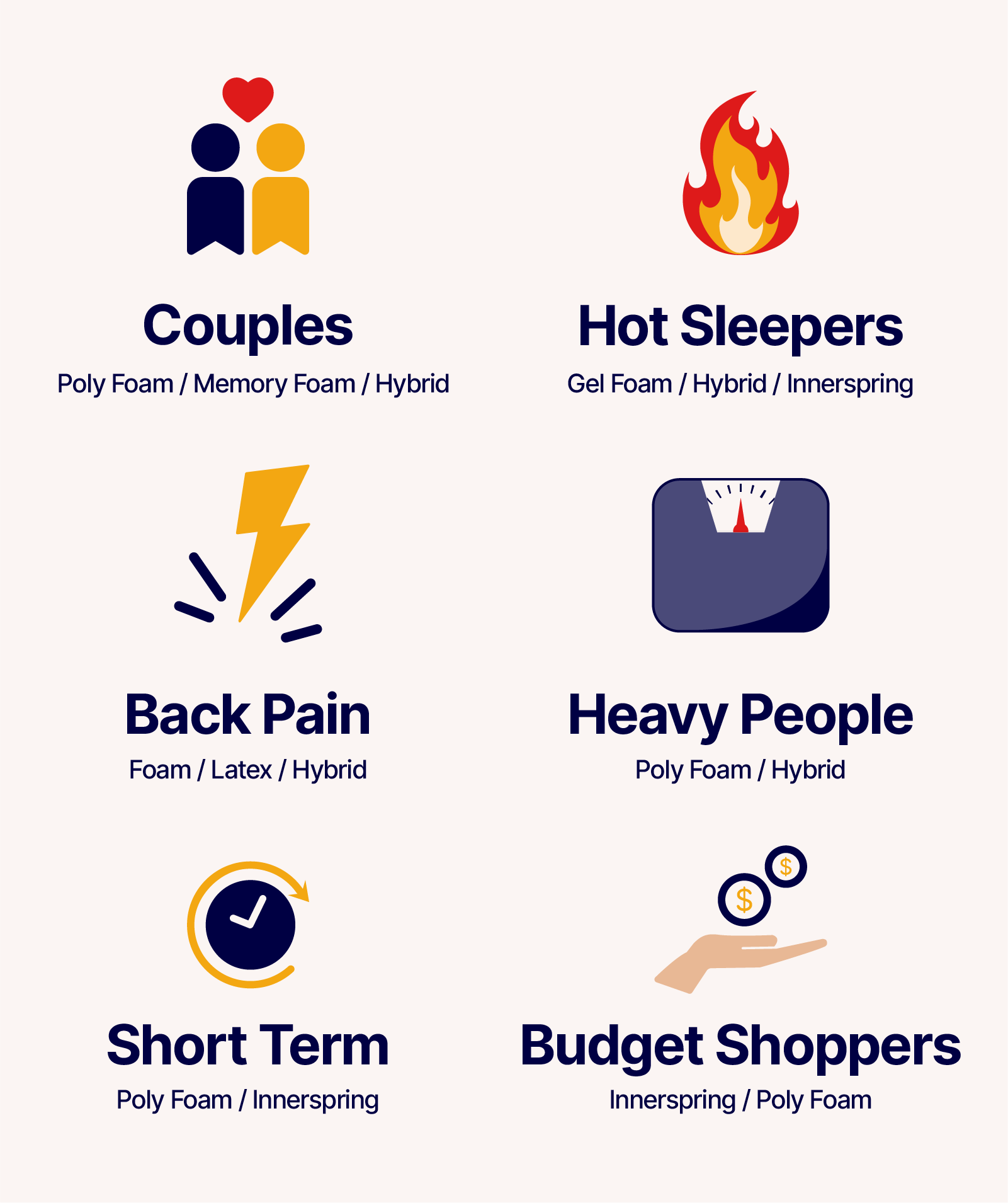
Best Type of Mattress for Couples
Couples should choose a poly foam, memory foam, or hybrid mattress due to their excellent motion isolation, contouring, and support for all sleep styles. Make sure to pick a mattress with cooling gel foam if you (or your partner) are a hot sleeper.
Our Recommendation: We recommend Douglas Original as the best mattress for couples. Its cooling gel comfort layer and pressure-point relief will provide a comfortable sleep, and its superior motion isolation will keep you from noticing your restless partner’s movements.
READ MORE: Get our list of the best mattresses for sex
Best Type of Mattress for Hot Sleepers
The best choice of mattress for hot sleepers is a gel foam, hybrid, or innerspring mattress. Gel-infused memory foam dissipates heat to keep you cool all night, while hybrid and innerspring mattresses contain coil systems that promote airflow.
Our Recommendation: We recommend Octave Vista and its advanced temperature-regulating technology for hot sleepers. This memory foam mattress has a moisture-wicking cover with cooling nanofibres to pull sweat away from your body, copper-infused gel memory foam treated with phase-change material that pulls heat away from your body and adapts to temperature changes so that you can enjoy a refreshing sleep surface. It also features five support zones that provide extra support to key areas like your shoulders, hips, and lower back.
READ MORE: See our list of the best cooling mattresses in Canada
Best Type of Mattress for Back Pain
The best mattresses for back pain are foam, latex, or hybrid. Look for features like gel foam—or individually wrapped pocket coils in a hybrid—along with contouring that aligns your spine aligned and supports your hips, shoulders, and joints.
Our Recommendation: Octave Vista is also the best mattress for back pain with its layers of memory foam, innovative five-zoned support, and pressure-point relief for all sleeping positions.
Best Type of Mattress for Heavy People
If you have a heavier body, hybrid and poly foam mattresses will help you stay supported and comfortable while you sleep. You may also want a firmer feel with advanced cooling features.
Our Recommendation: Logan & Cove Choice offers cooling gels and a reinforced central zone for added support beneath your shoulders, back, and hips. You can also upgrade to Logan & Cove Frontier or Logan & Cove Pinnacle for added layers of supportive micro-coils.
READ MORE: Get our list of the best mattresses for heavy people
Best Type of Mattress for Short-Term Sleepers
If you need a mattress for a short-term sleeper, like in a guest room, we recommend a poly foam or innerspring mattress. This should get you a quality product at a lower price point.
Our Recommendation: Our top pick for a short-term sleeper is Douglas Original, although Juno is an excellent second choice at a lower price point. Your guests will enjoy pressure-point relief, outstanding motion isolation, and cooling features.
Best Type of Mattress for Budget Shoppers
The best mattress options for budget shoppers are innerspring and poly foam mattresses. While you have a fixed budget, you still want comfort and support, and a mattress packed with great features for the price.
Our Recommendation: We rated Juno as Canada’s best value mattress for its medium-firm feel, cooling gel layer, and above-average motion isolation at just for a queen size.
READ MORE: Read our list of the best affordable mattresses
What’s the best foam mattress in Canada?
Douglas Original is our number-one choice for best foam mattress in Canada. It’s the perfect combination of quality, comfort, and value. Douglas comes with a cooling gel comfort layer, superior motion isolation, and excellent contouring support with minimal sinking. This keeps your spine aligned while making it easy to change sleeping positions.
Each Douglas mattress comes with a 365-night sleep trial, 20-year warranty, and worry-free return policy, all for just $799 for a queen size.
What’s the best hybrid mattress in Canada?
Logan & Cove Choice is the best Canadian hybrid mattress, according to our rating system that factors in third-party engineer testing (commissioned by us). Logan & Cove Choice was also rated “Best Luxury Hybrid Mattress” by Canadian Living and “Best Luxury Mattress” by Style Canada.
Logan & Cove earns this honour for its cooling features, three-zone support system, 365-night sleep trial, 15-year warranty, and affordable price tag at just 365 for a queen size. Logan & Cove also has thousands of verified customer reviews, an “A+” rating with BBB, and a Trustpilot score of “Excellent”.
What’s the best type of mattress for back problems?
The best type of mattress for back pain is typically a medium-firm foam mattress like Octave Vista. The mattress’s innovative five-zoned support system provides extra cushioning beneath your back, hips, and knees, giving targeted pressure-point relief where you need it most. In fact, the brand states that 86% of customers suffering from back pain said Octave helped reduce their pain.
Octave provides consistent ergonomic support throughout the night, keeping your spine aligned in any sleeping position. Octave also provides excellent motion isolation and edge support, a 365-night sleep trial, and a 15-year warranty.
READ MORE: What’s the best sleeping position for lower back pain?
What’s the best type of cooling mattress?
When you sleep hot, a cooling mattress is a must. Look for features like cooling gel, phase-change and temperature-balancing materials, centralized air channels, and cooling nanofibres for a refreshed sleep. Canada is a four-season country, so you’ll want to try out your cooling mattress for a full 365 nights to ensure it meets your cooling needs year round.
That’s why Octave is our pick for the best cooling mattress in Canada. It combines the ultimate cooling technologies with excellent motion isolation and body-contouring memory foam, along with a 365-night sleep trial and 15-year warranty. Get all this starting at just $899 for a queen size.
What’s the best type of mattress for heavy people?
Heavy people often sleep best on a mattress with a medium-firm feel and good support. Look for a mattress with multiple zones to properly align your spine and support your hips and lower back. You may also want advanced cooling features like cooling gel foam layers, breathable covers, phase-change materials, and breathable coils or open-cell designs to promote airflow.
Logan & Cove Choice is our number-one mattress for heavy sleepers with a 365-night sleep trial, 15-year warranty, and low price of just $999 for a queen size.
This hybrid mattress offers three-zoned support, with thicker pocket coils around the torso and hips for extra support. It also comes with gel foam, cooling nanofibres, and a coil support layer that provides excellent airflow.
READ MORE: Mattress Firmness Guide
Our goal is to provide the information you need to find the mattress that’s right for you. Get started with some of our most popular mattress shopping resources:
- Best Mattress Guides: Best Mattress Canada, Best Mattress In a Box
- Reviews: Douglas Original, Logan & Cove Choice, Juno, Octave Vista
- Comparisons: Douglas vs Endy, Douglas vs Casper
We use independent, third-party engineering firms (commissioned by us) with the APEGA stamp of approval to conduct mattress testing on our behalf, using publicly available data. We review and test all mattresses on 40+ criteria we think are important to you, including price, country of manufacture, sleep trial, warranty, features, materials used, motion isolation and edge support ratings, customer satisfaction reviews, returns, and refunds.
